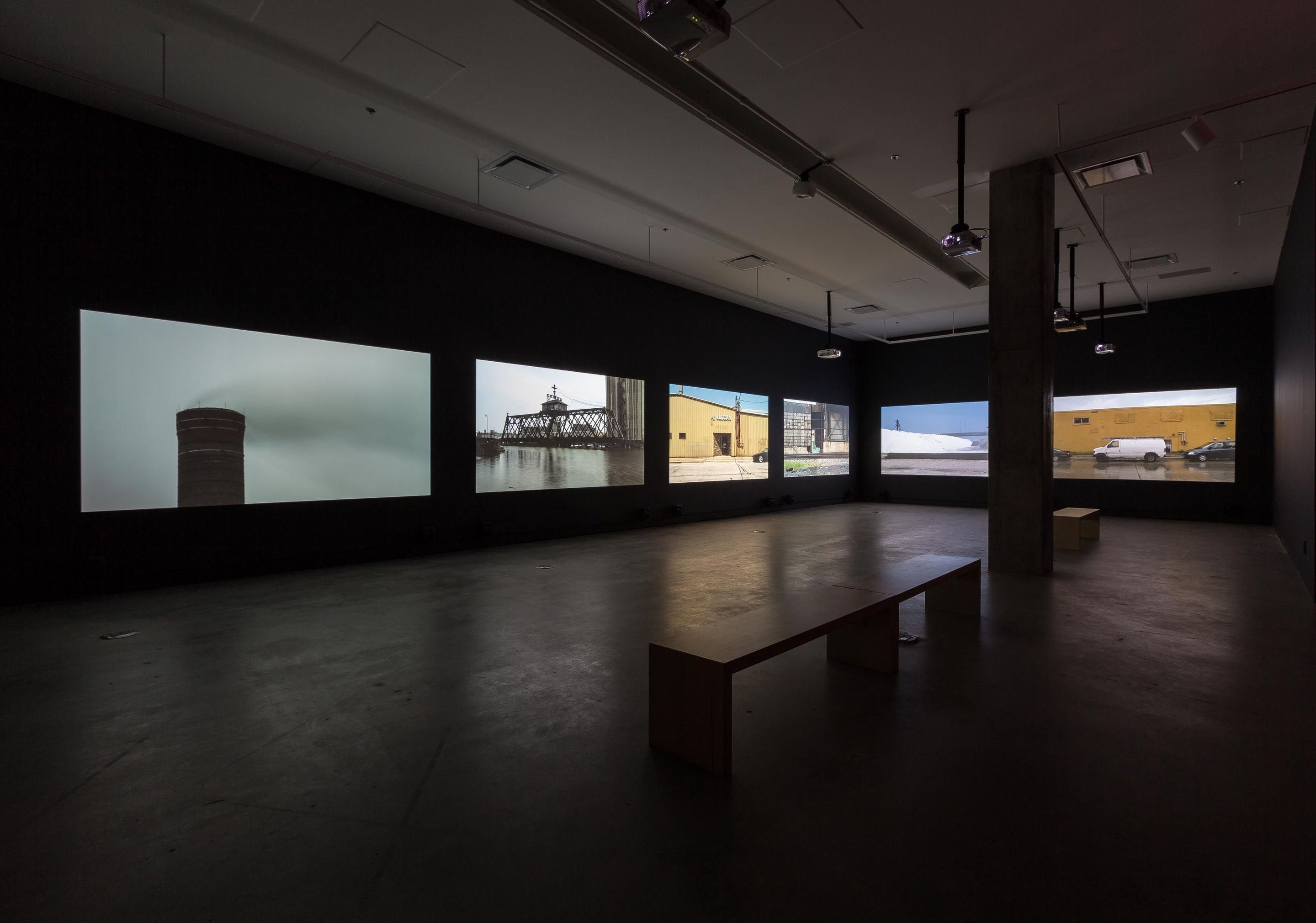
James Benning
2014.11.15 - 2015.02.21
GABE KLINGER
James Benning is referred to mostly as a filmmaker, though he prefers to define himself as a visual artist—an important and not gratuitous distinction. When his work is seen in the cinema, there is a contract that implies the viewer must stay from beginning to end, as they would with a conventional narrative. As Benning often deals with duration as a formal concept, the meaning is often revealed in the cumulative force of the experience as a whole. That is to say, his work can operate as “cinema,” and thus it’s easy to peg the term filmmaker onto him, and yet his work only grows richer and more complex in a fine art context, as the gallery experience allows us to discard the expectation of narrative, lending the work to conceptual interpretations and highlighting their performative, sculptural, architectural, and painterly components. While it may not be especially useful to divorce individual pieces that comprise works like One Way Boogie Woogie 2012 or Stemple Pass from their larger temporal designs, Benning’s work has nevertheless always tended to defy prescribed modes of spectatorship. The idea of overcoming the limitations inherent to each viewing space is a start to being able to discuss Benning’s peculiarity as a multi-hyphenate creator.
One Way Boogie Woogie 2012
“Landscape is… a function of time.” – JB
Benning’s three complimentary works One Way Boogie Woogie (1977), 27 Years Later (2004), and One Way Boogie Woogie 2012 focus on Milwaukee’s Industrial Valley, a horseshoe-shaped area surrounded by the Menomonee River directly adjacent to the location of where Benning’s childhood home once stood. Dick Hebdige writes that this area becomes “the very essence of place: a generic late industrial landscape that reads for [Benning] as a palimpsest of what Marcel Proust’s translators refer to as ‘lost time,’ a site of ruins stacked to overloading with personal and historical significance… [an] entry point and end game [in Benning’s life and oeuvre].1” Benning abstractly contrasts his own progression as a person and artist with that of the Valley’s fading industrial presence and slow gentrification. In 1977, the industry had already begun to move away, and by 2004 the landscapes had become radically different. Benning repeated the structure of the first film: 60-second long stationary shots of 60 locations—the same 60 locations—rough camera positions and, when available, people who appeared in the earlier iteration. In One Way Boogie Woogie 2012, which was created explicitly as an installation, the shots have been scaled down from 60 to 18, while shot lengths have been increased to five minutes and the presentation is lateral, alternated in six separate panels. Hebdige usefully notes:
“What may appear at first sight as an array of randomly ordered shots stands revealed over time as a single 90 minute film projected left to right from 6 separate but equidistant starting points in intervals of 3 i.e.:
S C R E E N
S 1, 4, 7, 10, 13, 16
H 2, 5, 8, 11, 14, 17
O 3, 6, 9, 12, 15, 18
T 4, 7,10, 13, 16, 1
. 5, 8 ………… etc.
After any three iterations all 18 shots will have appeared in the array and the film starts again in a different order. In this way the gallery visitor has an opportunity to scan (but not to ‘see’) a film that runs for 90 minutes in a theatrical setting in just 15 (though not in the ‘right’ order). Alternatively the viewer may stand in front of any screen for 90 minutes and watch all 18 shots play out in their entirety. One Way Boogie Woogie 2012 can be viewed either way—as a linear sequence of consecutive shots or as a laterally organized array of (slowly) moving images—though given that the average visitor to an art gallery or museum is estimated to spend less than 5 minutes in front of a work, it seems likely that some, at least, will simply sample. Scanning and sampling, however, are inimical to the concentrated forms of attention—of fully focused looking and listening—that Benning’ s oeuvre has always demanded and that the artist himself has in recent years been explicitly committed to promoting.2”
Stemple Pass
While designed for the cinema, Stemple Pass nevertheless offers a challenge to the intrepid gallery viewer. It’s one of Benning’s densest works, recalling his earlier American Dreams (lost and found) (1984) in the way that it constructs a powerful statement on outsiderness. Centring on “Unabomber” Ted Kaczynski, the project begins with the acquisition of the famed recluse’s notebooks from an FBI auction. The journals, written partly in numerical code, were subsequently deciphered by Benning using a mathematical computer program, which he himself designed; and then read by Benning (along with separate journal documents) inside a replica of Kaczynski’s cabin that, again, the artist himself created. Benning films the cabin in four stationary long shots, each in a different season, and layers the crudely recorded journal narration over the images. The cabin acoustics, in addition to the visual itself, lend the piece a sculptural dimension, and the structure and the process of how the project came into being enforce Benning’s preoccupations with duration, mathematics, nature, political contrarianism, and the American character. A conceptual tour de force—though if viewers prefer to see it as narrative—, Stemple Pass’s slow-burn suspense will send chills down one’s spine.
This exhibition is presented in partnership with the Rencontres internationales du documentaire de Montréal (RIDM). The festival holds a restrospective devoted to James Benning.